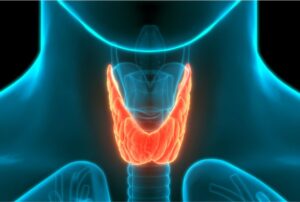This issue of Making a Difference! is brought to you by…
Dolores H. Pagano
845.386.1241
Send Us An Email
Go Shopping
In this issue…
♦ The care and feeding of your thyroid ♦ Common causes of thyroid disfunction…
♦ Anatomy of the thyroid gland ♦ How the thyroid feedback system works…
♦ How thyroid function affects other organs ♦ Diet and your thyroid
♦ 6 nutrients for thyroid health…
♦ 7 easy tips for spring cleaning ♦ How to use Basic H2
 “Health is not a tangible thing that can be held in the hand or dissected and viewed under a microscope. It is simply the normal expression of your Life Force. Anything which interferes with that expression produces DIS-EASE. Health is as natural as Nature, herself, but Nature is in a constant struggle to overcome the obstacles man places in her way. Man cannot take credit for building health, ever. HEALTH IS THE EXPRESSION OF LIFE, and man cannot create life.”
“Health is not a tangible thing that can be held in the hand or dissected and viewed under a microscope. It is simply the normal expression of your Life Force. Anything which interferes with that expression produces DIS-EASE. Health is as natural as Nature, herself, but Nature is in a constant struggle to overcome the obstacles man places in her way. Man cannot take credit for building health, ever. HEALTH IS THE EXPRESSION OF LIFE, and man cannot create life.”
~ A Study Course in Nutrition by Forrest Shaklee Sr., DC, DD
The Shaklee Story
The care and feeding of your thyroid
What do you know about your thyroid? Not much? Without a normally functioning thyroid gland, humans are faced with various negative consequences due to the body’s hindered ability to break down protein and process carbohydrates.
The thyroid gland is a small but essential organ that plays a vital role in regulating the body’s metabolism and energy levels.
A distortion in thyroid hormone synthesis can lead to a range of health issues, and it’s important to understand that hormone production and regulation is a complex mechanism involving the brain, thyroid, and other organs.
Whether it’s weight gain, malnutrition, or another disease exacerbation, thyroid dysfunction in some capacity is experienced by over 10% of the US population, according to the ATA (American Thyroid Association).
So… it’s important to take care of your thyroid gland and be aware of any problems early on. This starts with learning about its structure and how it affects your body.
Common causes of thyroid disfunction…
♦♦ Autoimmune disorders such as Hashimoto’s thyroiditis and Graves’ disease.
♦♦ Congenital defects can result in markedly decreased mental development.
♦♦ Iodine deficiency which can cause a goiter to develop and can lead to hypothyroidism.
♦♦ Radiation exposure can cause direct damage to the thyroid gland.
♦♦ Medications such as lithium and amiodarone can cause thyroid problems.
Anatomy of the thyroid gland
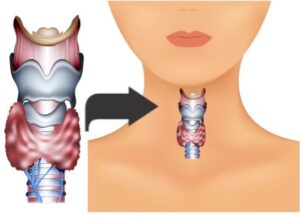 The thyroid gland is a small butterfly-shaped organ located at the base of the neck, just below the laryngeal thyroid cartilage (Adam’s apple). The thyroid is part of the endocrine system and is responsible for producing hormones that regulate the body’s metabolism and energy levels.
The thyroid gland is a small butterfly-shaped organ located at the base of the neck, just below the laryngeal thyroid cartilage (Adam’s apple). The thyroid is part of the endocrine system and is responsible for producing hormones that regulate the body’s metabolism and energy levels.
Made up of two lobes on either side of the trachea, the thyroid gland is connected by a narrow band of tissue called the isthmus. Each lobe is about the size of a large almond and is surrounded by a capsule of connective tissue. In some individuals, the gland is able to be palpated, but in many individuals, it is hardly noticeable.
As a gland involved in the endocrine system, the thyroid gland is supplied with blood vessels, nerves, and lymphatic vessels. The thyroid has a rich vascular supply which assists in the efficient release of thyroid hormones into the bloodstream. Inside the gland, there are tiny follicles that produce and store the hormones that affect metabolism. These follicles are lined with a single layer of cells called follicular cells, which are responsible for producing and secreting thyroid hormones.
Thyroid cellular function
Though the thyroid is involved in several roles, the primary cellular function of the thyroid gland is to produce and secrete hormones that are responsible for regulating the body’s metabolism 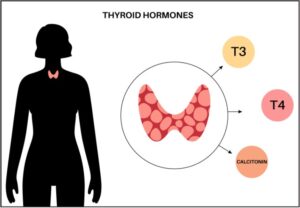 and energy levels.
and energy levels.
The thyroid gland produces two main hormones: triiodothyro-nine (T3) and thyroxine (T4), which are secreted into the bloodstream. Other hormones produced and secreted by the thyroid gland include reverse triiodothyronine (RT3) and calcitonin. Calcitonin reverses the effects of T3 and regulates calcium levels, respectively.
These hormones are iodine-containing compounds that are synthesized and secreted by the thyroid gland’s follicular cells. T3 is the more active of the two hormones, while T4 is considered the pro-hormone, which means that it is converted into T3 in other parts of the body.
The production of these hormones is regulated by the hypothalamus and pituitary gland in the lower aspect of the brain, working in a synergistic, positive feedback loop system (see accompanying article), optimizing metabolism and energy production.
 An imbalance in the production of these hormones can lead to various health issues, such as hypothyroidism, hyperthyroidism, and Grave’s disease. Cancers of the thyroid, such as papillary thyroid carcinoma, as well as inflammatory thyroid disorders, can be a primary reason for abnormalities of thyroid hormone production.
An imbalance in the production of these hormones can lead to various health issues, such as hypothyroidism, hyperthyroidism, and Grave’s disease. Cancers of the thyroid, such as papillary thyroid carcinoma, as well as inflammatory thyroid disorders, can be a primary reason for abnormalities of thyroid hormone production.
How the thyroid feedback system works…
⇒⇒ The hypothalamus produces thyrotropin-releasing hormone (TRH), which stimulates the pituitary gland to produce thyroid-stimulating hormone (TSH).
⇒⇒ TSH then travels through the bloodstream to the thyroid gland, where it stimulates the production and release of T3 and T4.
⇒⇒ Depending on whether or not the body needs more or less of these thyroid hormones, a normally functioning thyroid gland will produce optimal amounts on an as-needed basis.
⇒⇒ The amounts of particular hormones that are secreted are largely controlled by the brain (i.e., the hypothalamus and the pituitary gland).
This feedback loop ensures that the body has the correct amount of thyroid hormones at all times, thus optimizing the body’s metabolic function and energy production throughout. As long as this feedback system is functioning properly, the body’s homeostasis remains normal.
In addition, T3 and T4 play a role in the rate at which the body burns calories, as well as in the growth and development of the body and the functioning of the heart and nervous system.
How thyroid function affects other organs
Part of the endocrine system, the thyroid is primarily responsible for producing, releasing, and controlling certain hormones that have direct effects on the body. These thyroid hormones include thyroxine (T4) and triiodothyronine (T3).
When the levels of these hormones are altered, it has a direct effect… and some indirect effects… on nearly every organ in the body, including the two most important organs… the brain  and the heart.
and the heart.
These effects lead to symptoms involving those other organ systems, such as cognitive impairments, GI complications like constipation, musculoskeletal issues, and heart effects such as irregular rhythms.
Low thyroid function
When the thyroid gland does not produce enough hormones (hypothyroidism), it can lead to a decrease in overall brain function, mood swings, depression, and anxiety attacks, even neuro-degenerative diseases such as Alzheimer’s and dementia.
Thyroid hormones help regulate heart rate, so a decrease in thyroid hormones can result in a slower heart rate (bradycardia), leading to. fatigue, weakness, and lightheadedness. Those affected also experience shortness of breath and palpitations and can increase the risk of heart failure. Low thyroid levels can also result in elevated cholesterol.
High thyroid function
Hyperthyroidism, in which the thyroid gland produces too much thyroid hormone, can cause  anxiety issues such as nervousness, worry, and fear, sometimes leading to panic attacks, which are characterized by fear, sweating, rapid heart rate, and shortness of breath.
anxiety issues such as nervousness, worry, and fear, sometimes leading to panic attacks, which are characterized by fear, sweating, rapid heart rate, and shortness of breath.
Hyperthyroidism can cause increased activity in the heart muscles, leading to an increased heart rate, palpitations, shortness of breath, and chest pain. It can also lead to an enlarged heart, increasing the risk of high blood pressure and congestive heart failure.
Diet and your thyroid
Understanding how diet can affect your thyroid is key to keeping it healthy.
The most important thing with any diet is getting enough vitamins and minerals in each day. Some of these nutrients are known as “goitrogens” and they include cruciferous vegetables such as kale and broccoli, which contain substances that may interfere with the production of thyroid hormones if eaten raw and in large amounts. Cooked cruciferous veggies can be consumed when the body has a healthy level of iodine. Additionally, getting enough foods that are rich in zinc and omega 3 fatty acids is necessary for maintaining proper hormone levels throughout the body. Omega 3’s also help prevent inflammation which can hinder the conversion of T3-to-T4 within your system.
consumed when the body has a healthy level of iodine. Additionally, getting enough foods that are rich in zinc and omega 3 fatty acids is necessary for maintaining proper hormone levels throughout the body. Omega 3’s also help prevent inflammation which can hinder the conversion of T3-to-T4 within your system.
Lastly, ensuring that you have enough selenium in your daily intake is important to help maintain the building blocks of new thyroid hormone while also enabling existing thyroid hormone to break down into more absorbable forms.
6 nutrients for thyroid health…
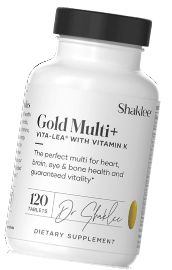 ____ Iodine… is crucial for a healthy thyroid. About 30 percent of the world population is low in iodine, which can lead to hypothyroidism. Vita-Lea, taken daily, provides an ideal amount of iodine.
____ Iodine… is crucial for a healthy thyroid. About 30 percent of the world population is low in iodine, which can lead to hypothyroidism. Vita-Lea, taken daily, provides an ideal amount of iodine.
____ Selenium… protects the thyroid gland from inflammation  and works with iodine to form thyroid hormones. Both Vita-Lea and Vita-E Complex provide selenium.
and works with iodine to form thyroid hormones. Both Vita-Lea and Vita-E Complex provide selenium.
____ Zinc… in combination with copper, zinc is important to balance the two key hormones released by the thyroid… thyroxine (T4) and triiodothyronine (T3) and is necessary to convert T4 to T3. Vita-Lea provides both nutrients in proper balance.
____ Omega-3 fatty acids… help balance the body’s inflammatory response, benefitting the thyroid gland. Take OmegaGuard to ensure you’re getting enough.
____ Iron… important to maintain optimal levels of thyroid peroxidase (TPO), a protein found in thyroid cells. Both Vita-Lea and Iron Plus C Complex provide iron.
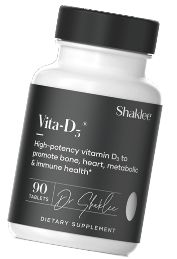 ____ Vitamin D… helps prevent thyroid disease caused by low levels. Since 40% of Americans are deficient in this vitamin, taking Vita-D3 is a wise move.
____ Vitamin D… helps prevent thyroid disease caused by low levels. Since 40% of Americans are deficient in this vitamin, taking Vita-D3 is a wise move.
____ Magnesium… assists with iodine uptake by thyroid cells. Vita-Lea and Sustained Release VitalMag both provide magnesium.
The Science Behind Our Natural Products
7 easy tips for spring cleaning
Spring is here and that means it’s time to do a deep clean of your house. Here are a few tips and guidelines to help you tackle spring cleaning:
Plan your cleaning
Build your schedule and checklist on a calendar. Plan when and where you’re going to clean each day. Prioritize the rooms that need the most attention. When you complete a room, check it off. Progress!
De-clutter first
 Before you clean a room, declutter it. Get rid of things you no longer need. Hold a garage sale, donate to a charity, or fill up your recycling bin to make cleaning and organizing much easier.
Before you clean a room, declutter it. Get rid of things you no longer need. Hold a garage sale, donate to a charity, or fill up your recycling bin to make cleaning and organizing much easier.
Involve family
Spring cleaning is the perfect time to involve the kids. It makes a huge difference in workload when the family helps.
Clean top to bottom
Start with the ceiling and work your way down to the floor. This will avoid double cleaning as dirt, dust, and debris fall to your furniture or floor.
Think about the air
Clean the dust that builds up over your windows, vents, and ducts. Use air filters or air purifiers. And when you choose cleaners, choose Get Clean.
 Use the right tools
Use the right tools
Make sure you have a fresh set of sponges, brushes, and dusters to do your cleaning.
Pick cleaners that fit
Different cleaners have different applications! Learn how to use always-green Get Clean cleaners that won’t emit harmful fumes and chemicals.
Then sit back, relax, and enjoy your fresh, clean home!
How to use Basic H2
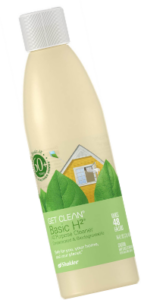 ____ Windows, mirrors, and other glass surfaces: Mix 1–2 drops of Basic H2 with 16 oz. of water in a spray bottle.
____ Windows, mirrors, and other glass surfaces: Mix 1–2 drops of Basic H2 with 16 oz. of water in a spray bottle.
____ Sealed countertops, tiles, sealed woodwork, furniture, and other general-purpose uses: Mix ¼ teaspoon of Basic H2 with 16 oz. of water in a spray bottle.
____ Nonporous floors: Mix 1 tablespoon of Basic H2 with 1 gallon of water.
____ Ovens, microwaves, stovetops, cooking surfaces, kitchen appliances: 1½ teaspoons of Basic H2 combined with 16 oz. of water in a spray bottle.
____ Pots, pans, grills, barbecues, driveways, and engine grease: 2 oz. of Basic H2 combined with 1 gallon of water.
Get Clean Basic-H2, from Shaklee

